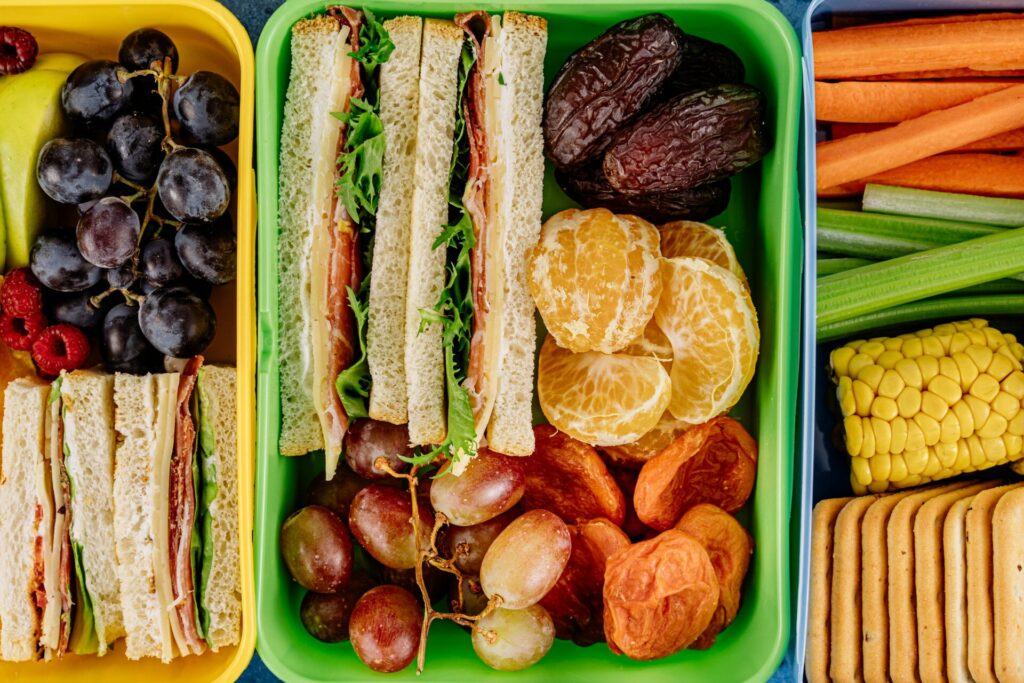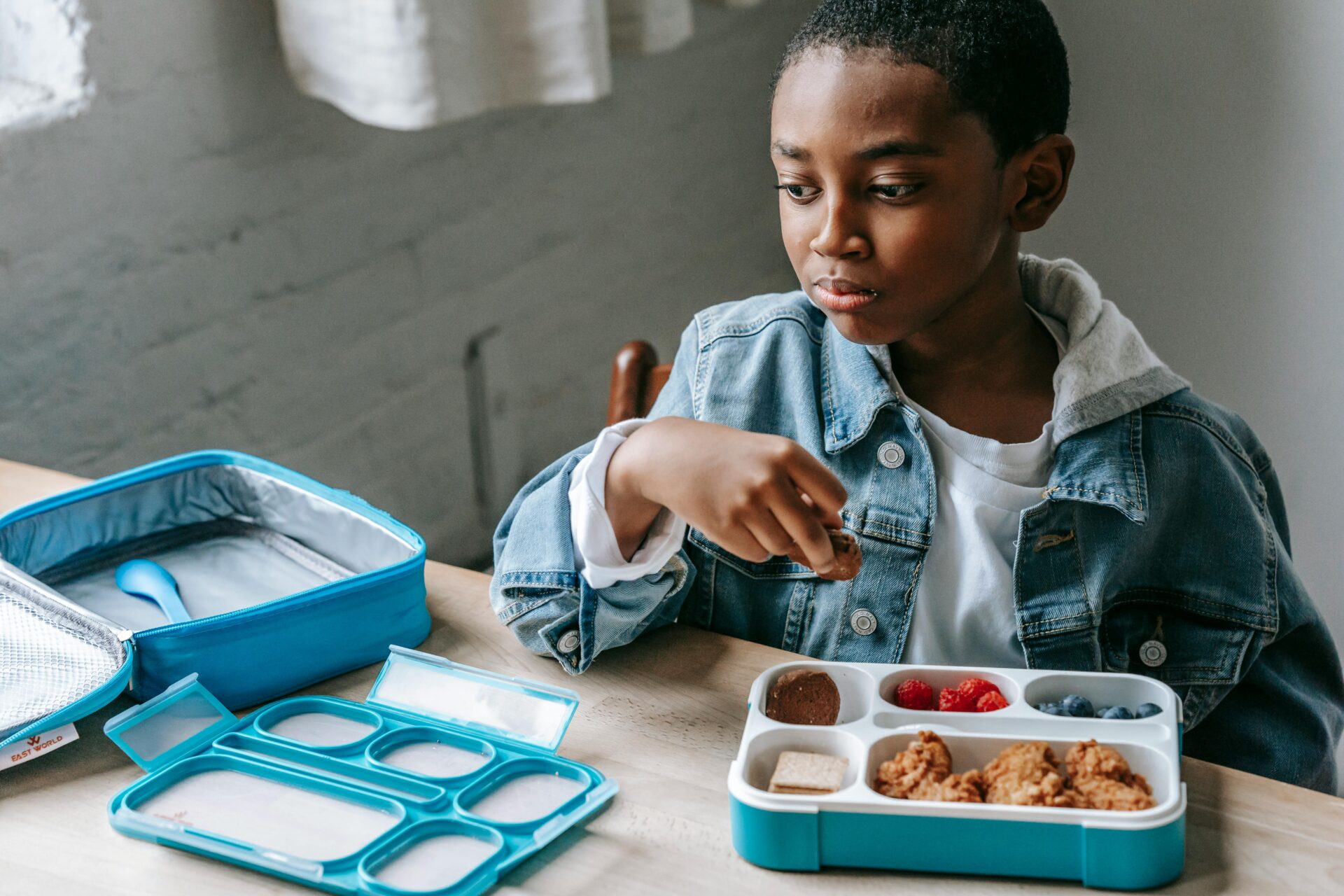As a parent of school aged kids, packing lunch for your picky eater can feel like a daily battle. You want to provide nutritious lunches that are easy to prep, but your child seems to turn their nose up at anything that isn’t their favorite food.
Don’t worry – you’re not alone in this struggle!
Picky eating is a common phase for many children, but it can be concerning and rather frustrating for parents. The good news is that with a bit of creative strategy and patience, you can make lunchtime at school more simple, enjoyable and nutritious for your child.
We’ve got 5 practical tips to help you pack lunches that your picky eater will actually eat. These strategies are based on our experience in feeding and nutrition therapy, where we help children and families expand their food choices, overcome feeding challenges and develop healthy eating habits overall.

Tip #1: Involve Your Picky Eater in Food Prep
One of the most effective ways to get your picky eater not just interested in their school lunches but more invested is to involve them in the planning and preparation process.
Here’s a few ideas of how you can do that:
- Offer Choices
Give your child a say in what goes into their lunch box. For example, ask “Would you like carrot sticks or cucumber slices with your sandwich?” This gives them a sense of control while also ensuring they get a healthy option. - Go Shopping Together
Take your child grocery shopping and let them pick out new fruits, vegetables or other foods they’d like to try. Allow them to make choices independently while continuing to give them choices. - Get Them in the Kitchen
Involve your child in simple food preparation tasks. They can:- Wash fruits and vegetables
- Spread butter or hummus on bread
- Assemble their own sandwich or wrap
- Pack their lunchbox
When kids are involved in meal planning and prep, they’re more likely to be interested in the food.
It also gives them a sense of ownership, accomplishment and some control over their food. Plus, it’s a great opportunity to teach them about different foods and basic, healthy nutrition.
Remember, the goal isn’t just to get your child to eat their lunch – it’s to help them develop a positive relationship with food. By involving them in the process, you’re laying the groundwork for healthier eating habits in the long run.
Tip # 2: Make Food Fun & Visually Appealing
We eat with our eyes first, and this is especially true for kids. Making lunch a bit more visually exciting can turn a picky eater into an interested eater.
Try these fun ideas:
- Use Cookie Cutters
Transform ordinary sandwiches into fun shapes like stars, hearts, or dinosaurs. This works great for cheese slices, fruits, and even vegetables too! - Create Food Art
Arrange food to look like faces, animals, or scenes. For example:- Make a smiley face with cherry tomatoes for eyes and a cucumber slice for a mouth
- Create a butterfly using carrot sticks for the body and cucumber rounds for wings
- Use Colorful Foods
Brighten up the lunchbox with a rainbow of fruits and vegetables. The more colors, the more appealing (and nutritious) the meal! - Invest in Fun Containers
Bento-style boxes with separate compartments can make lunch more interesting. Kids love opening each section to discover what’s inside.
We want to make healthier food options look inviting and fun to eat! Even if your child doesn’t eat everything at first, they’re more likely to engage with food if it’s presented in a more appealing way.
Tip #3: Offer Variety in Smaller Portions
Variety is the key to a balanced diet, but that variety can be overwhelming for picky eaters.
Here’s how to introduce variety without causing mealtime stress:
- Use the “Rule of 1’s”
Pack lunch using this simple formula:- 1 protein (e.g., chicken, eggs, beans)
- 1 grain (e.g., whole wheat bread, pasta, rice)
- 1 fruit
- 1 vegetable
- Keep Portions Small
Offer new or less-preferred foods in tiny portions. This makes trying new things less daunting and stressful for your child. - Mix Familiar and New
Include one or two foods you know your child likes, along with small portions of new or previously rejected foods. - Rotate Foods
Don’t serve the same things every day. Rotate through different options within each food group to expose your child to a variety of tastes and textures.
Smaller portions of various foods, especially those that have previously been rejected, allows your child to try without feeling pressured or overwhelmed. They might not eat everything, but repeated exposure is key.
Research shows that children often need to see a food 8-15 times before accepting it! So don’t give up too soon.
In our feeding therapy sessions, we often use this approach to gradually expand a child’s food repertoire. By offering variety at home, you’re supporting your child’s journey towards more diverse eating habits.
Remember, the goal isn’t to force your child to eat everything, it is to provide opportunities for them to explore, and eventually accept, a wider range of foods. Be patient and celebrate small victories – even if it’s just your child touching or smelling a new food without eating it, that’s a win!
Tip #4: Focus on Nutrient-Dense Foods
When dealing with a picky eater, it’s important to make sure that every bite counts.
Here’s how to pack lunches that are both picky-eater appealing and nutritious:
- Choose Power-Packed Foods
Opt for foods that offer a lot of nutrition in small servings. For example:- Greek yogurt instead of regular yogurt (more protein)
- Berries instead of grapes (more vitamins and fiber)
- Almond butter instead of regular butter (healthy fats and protein)
- Sneak in Nutrients
Add finely grated vegetables to foods your child already likes:- Mix pureed cauliflower into mac and cheese
- Add grated carrots or zucchini to muffins or quick breads
- Blend spinach into smoothies or homemade popsicles
- Offer Nutrient-Rich Alternatives
Swap less nutritious favorites for healthier options:- Sweet potato fries instead of regular fries
- Whole grain crackers instead of chips
- Fruit leather made from 100% fruit instead of gummy snacks
Proper nutrition supports your child’s growth, development, and ability to learn. By focusing on nutrient-dense foods, you’re supporting your child’s overall health, even if their diet seems limited.
Tip #5: Be Consistent & Patient
Changing habits takes time and for picky eaters, changing food habits can feel like a never-ending challenge. But we promise, your persistence will pay off.
Here’s how to stay the course:
- Stick to a Routine
Outside of school lunches, offer meals and snacks at consistent times each day. This helps regulate hunger and makes children more likely to try new foods. - Keep Offering
Don’t give up on a food just because your child rejects it once. It can take up to 15 exposures before a child accepts a new food so keep at it. - Remain Neutral
Avoid pressuring your child to eat or showing frustration if they don’t. Keep mealtimes positive, stress-free and focused on healthy eating, not compliant eating. - Model Good Eating & Food Behavior
Let your child see you enjoying a variety of healthy foods. Children often learn eating habits by watching their parents so make sure you are modeling positive and healthy food behavior. - Celebrate Small Wins
Praise your child for tiny steps such as:- Touching or smelling a new food
- Licking or taking a tiny taste
- Helping to prepare a meal with a new ingredient
Consistency and patience are key in feeding therapy, and the same applies at home. Remember, your goal is to help your child develop a healthy relationship with food, not just to get them to eat specific items.
It’s normal to feel frustrated when dealing with a picky eater, but try to focus on your long term goal – to create healthy habits and relationships with food. With consistent exposure and a positive approach, most children will expand their food choices over time.
Packing lunch for your picky eater doesn’t have to be a daily struggle! By getting them involved, making food fun, focusing on nutrient-dense options, and remaining patient, you can improve your child’s relationship with food.
If you’re still facing challenges with your picky eater, don’t hesitate to seek professional help. Our in-home feeding and nutrition services can provide personalized strategies and support to help your child and family in developing healthier eating habits and work through feeding challenges.
Reach out to us at Beyond Speech Therapy Specialists and we can connect you with one of ourRegistered Dietitians. Let’s take the first step towards happier, healthier mealtimes for your family!

